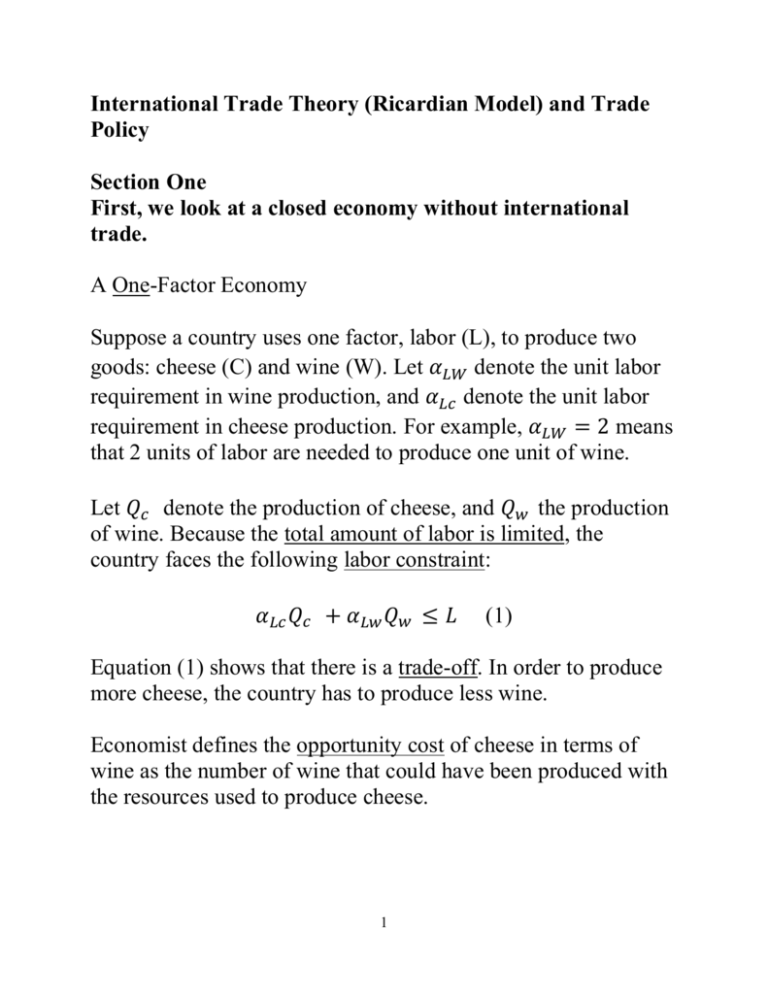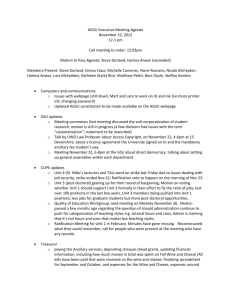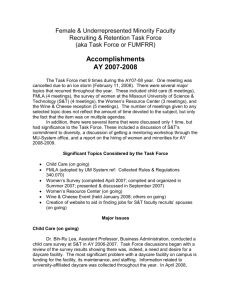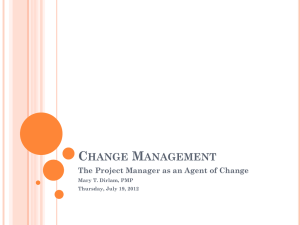relative price
advertisement

International Trade Theory (Ricardian Model) and Trade Policy Section One First, we look at a closed economy without international trade. A One-Factor Economy Suppose a country uses one factor, labor (L), to produce two goods: cheese (C) and wine (W). Let 𝛼𝐿𝑊 denote the unit labor requirement in wine production, and 𝛼𝐿𝑐 denote the unit labor requirement in cheese production. For example, 𝛼𝐿𝑊 = 2 means that 2 units of labor are needed to produce one unit of wine. Let 𝑄𝑐 denote the production of cheese, and 𝑄𝑤 the production of wine. Because the total amount of labor is limited, the country faces the following labor constraint: 𝛼𝐿𝑐 𝑄𝑐 + 𝛼𝐿𝑤 𝑄𝑤 ≤ 𝐿 (1) Equation (1) shows that there is a trade-off. In order to produce more cheese, the country has to produce less wine. Economist defines the opportunity cost of cheese in terms of wine as the number of wine that could have been produced with the resources used to produce cheese. 1 Three steps to obtain the opportunity cost of cheese in terms of wine: Step 1: 1 labor can produce ____ wine Step 2: producing 1 unit of cheese needs _____ labor Step 3: that amount of labor in step 2 can produce____ wine Therefore, the opportunity cost of cheese in terms of wine is ___. The meaning of the opportunity cost is__________________ Equation (1) can be used to draw production possibility frontier (PPF), which shows the maximum amount of cheese that can be produced once the decision has been made to produce any given amount of wine, and vice versa. Four steps to draw PPF: Step 1: If the country produces 𝐿/𝛼𝐿𝑤 wine, the maximum amount of cheese that can be produced is________ Step 2: If the country produces 0 wine, the maximum amount of cheese that can be produced is________ Step 3: Put the production pairs obtained in Steps 1 and 2 in a two-dimensional diagram in which the vertical axis denotes 𝑄𝑤 and the horizontal axis denotes 𝑄𝑐 . Step 4: Connect those two points and we get PPF. 2 Remarks about PPF: (1) Because we assume there is only one factor and unit labor requirement is constant, the PPF is a straight line (2) The opportunity cost of cheese in terms of wine equals the absolute value of the slope of the PPF Without international trade, this country is a closed economy, and has to produce both cheese and wine. Both goods are produced only if the relative price of cheese in terms of wine, 𝑃𝑐 /𝑃𝑤 , is equal to the opportunity cost of cheese in terms of wine: 𝑃𝑐 𝑃𝑤 = 𝛼𝐿𝑐 𝛼𝐿𝑤 (2) To see this, note (1) (2) (3) (4) We assume no profits in the one-factor model. Revenue of producing unit of cheese is ______ Labor cost of producing unit of cheese is ______ No profit means that revenue equals cost. So the wage rate in the cheese industry is_______ (5) In a similar fashion we can show the wage rate in the wine industry is_______ Because everyone wants to work in whichever industry offers the higher wage, the economy will specialize in the production of cheese if the wage rate in the cheese industry is greater than that in the wine industry, i.e., ___________; the country will 3 specialize in the produce of wine if___________; only when equation (2) holds will both goods be produced. Key Lesson 1 A country will specialize in the production of the goods if the relative price of that goods exceeds its opportunity cost. Key Lesson 2 In the absence of international trade, the relative price of goods is equal to their relative unit labor requirement. Section Two We look at what change will happen after the closed economy opens to international trade. We assume there are two countries in world: Home Country and Foreign Country (denoted by *). Home country is said to have comparative advantage in producing X if either of the following two holds (I) the opportunity cost of X in terms of Y in home country is lower than that in foreign country. (II) the relative unit labor requirement in X production in home country is lower than that in foreign country 4 Key Lesson 3 Each country will specialize in the production of the good in which it has comparative advantage. To see this, suppose, without loss of generality, that the home country has comparative advantage in producing cheese. That means the relative unit labor requirement in cheese production in home country is lower than that in foreign country: ∗ 𝛼𝐿𝑐 𝛼𝐿𝑐 < ∗ 𝛼𝐿𝑤 𝛼𝐿𝑤 Remarks: (1) Home country is said to have absolute advantage in ∗ producing cheese if 𝛼𝐿𝑐 < 𝛼𝐿𝑐 . Absolute advantage does not matter for trade. (2) Comparative advantage involves four unit labor requirements, not just two. (3) It is possible that a country has absolute advantage in both goods. However, it is impossible that a country has comparative advantage in both goods. Put differently, one country must have comparative advantage in some goods Proof of (3): 5 Before each country opens to international trade, the domestic relative prices equal the opportunity costs (recall equation (2)): 𝑃𝑐 𝑃𝑤 = 𝛼𝐿𝑐 𝛼𝐿𝑤 , 𝑃𝑐∗ ∗ 𝑃𝑤 ∗ 𝛼𝐿𝑐 = 𝛼∗ (3) 𝐿𝑤 Since we assume 𝛼𝐿𝑐 𝛼𝐿𝑤 ∗ 𝛼𝐿𝑐 < ∗ 𝛼𝐿𝑤 Then it follows that 𝑃𝑐 𝑃𝑐∗ < ∗ 𝑃𝑤 𝑃𝑤 So the relative price of cheese in home country is lower than that in foreign country. (To get this point quickly, notice that the PPF of home country is flatter than the foreign country) This difference in relative prices, which is a signal for disequilibrium in international markets, will cause people to do arbitrage as follows: In home country, one person can sell one unit of wine and get the receipt of______. He can use that receipt to buy ____ cheese. Or, that person can sell one unit of wine in foreign country, and get the receipt of______. He can use that receipt to buy ____ cheese in foreign country. So one can buy (more or less) cheese in home country than in foreign country. 6 Then everyone will try to buy cheese and sell wine in home country, and this will push home cheese price up and home wine price down. The opposite will happen in foreign country, where everyone will try to sell cheese and buy wine, pushing foreign cheese price down and foreign wine price up. Arbitrage will continue until the home relative price and foreign relative price converge to a final level that satisfies: 𝑃𝑐 𝑃𝑤 𝑓𝑖𝑛𝑎𝑙 < 𝑃𝑐 𝑓𝑖𝑛𝑎𝑙 𝑃𝑤 𝑃𝑐∗ < 𝑃∗ 𝑤 (4) Key Lesson 4 The post-trade relative price lies between the pre-trade relative prices. Because of (3), Equation (4) can be rewritten as 𝛼𝐿𝑐 𝛼𝐿𝑤 𝑓𝑖𝑛𝑎𝑙 < 𝑃𝑐 𝑓𝑖𝑛𝑎𝑙 𝑃𝑤 ∗ 𝛼𝐿𝑐 < 𝛼∗ 𝐿𝑤 7 (5) The fact that 𝑓𝑖𝑛𝑎𝑙 𝑃𝑐 𝑓𝑖𝑛𝑎𝑙 𝑃𝑤 > 𝛼𝐿𝑐 𝛼𝐿𝑤 , implies that the after-trade relative price of cheese is higher than the opportunity cost of cheese. So after the home country opens to international trade, the home country will specialize in producing cheese, for which the home country has comparative advantage. Exercise: Show that after trade, the foreign country will specialize in producing wine, for which the foreign country has comparative advantage To sum up, arbitrage will cause (1) the convergence in relative prices (2) each country to specialize in the production of the good for which it has comparative advantage. Please comment on the following two statements: (1) It is pointless for some African countries to join the international trade because they are so poor, so backward, 8 and there is no way that they can compete with the developed and rich countries. (2) USA should produce and export everything because USA workers have the highest productivity in world. Section Three We look at how both countries gain from the international trade (or specialization). One way to show that trade is beneficial is to think of trade as an indirect method of production. Before the trade, the home country produces wine directly. After the trade, the home country specializes in cheese. But the trade with foreign country allows the home country to indirectly “produce” wine by trading cheese for wine. Three steps to show trade (or specialization) is beneficial: Step 1: Before the trade one unit of labor can produce ______ wine in home country Step 2: After the trade one unit of labor can produce ______ cheese in home country, and that amount of cheese can be traded for _______ wine 9 Step 3: home country benefits from trade because the wine it gets in step 2 is (more or less) than that in step 1. You may review Equation (5) to fully understand this. To sum up, the home country can “produce” wine more efficiently by making cheese and trading it for wine than by producing wine directly. Exercise: Please show how foreign country can benefit from trade (or specialization in wine) Exercise: Please show how US benefit from trade by shifting the textile industry to China or Vietnam. Exercise: Please show how US benefit from trade by outsourcing those call-center jobs to India. 10 Exercise: Please comment on the statement that “US should keep its manufacturing jobs” Section Four We look at the effect of trade policy on welfare Instruments of trade policy include tariff, quotas and subsidies. We focus on tariff. A tariff is a tax levied when a good is imported. The effect of a tariff is to raise the cost of shipping goods to a country. Historically tariff was used as a source of government income. Now governments use tariff to protect particular domestic sectors. Suppose there are two countries, Home and Foreign, and there is only one good, wheat. Before the trade, the home wheat price, 𝑃𝐴 , is determined by home demand and home supply of wheat. The demand-andsupply diagram for Home looks like 11 Before the trade, the foreign wheat price, 𝑃𝐴∗ , is determined by foreign demand and foreign supply of wheat. The demand-andsupply diagram for Foreign looks like We assume 𝑃𝐴 > 𝑃𝐴∗ , so the pre-trade wheat price in Home is higher than Foreign. Given this difference in prices, people will do arbitrage by buying wheat in Foreign, and selling wheat in Home. This will push the home price (up or down), and foreign price (up or down). The arbitrage will continue until the two prices converge to the post-trade price, 𝑃𝑊 . Three steps to obtain the post-trade price, 𝑃𝑊 : Step 1: We derive the home import demand (ID) curve. The home import demand is the excess demand for any given price. The ID curve is downward-sloping because excess demand (imports) rises when prices falls. 12 Step 2: We derive the foreign export supply (ES) curve. The foreign export supply is the excess supply for any given price. The ES curve is upward-sloping because excess supply (exports) rises when prices rises. Step 3: The intersection of home import demand curve and foreign export supply curve determines 𝑃𝑊 and 𝑄𝑊 where 𝑄𝑊 is the amount of import Mathematically, 𝑃𝑊 clears the world wheat market in the sense that at 𝑃𝑊 World demand = World supply 13 With tariff 𝑡 in place, shippers are not willing to move wheat from foreign to home unless the home price exceeds the foreign price by at least 𝑡. If no wheat is being shipped, however, there will be an excess demand for wheat in Home and an excess supply in Foreign. Thus the Home price will rise and the Foreign price will fall until the price difference is 𝑡 Introducing a tariff drives a wedge between the prices in Home and Foreign. The tariff raises the Home price to 𝑃𝑇 and lowers the foreign price to 𝑃𝑇∗ = __________ Three steps to show the effect of tariff on imports and exports Step 1: In the ID-and-ES diagram, a tariff wedge is put between the ID and ES curve. The home price changes from ____ to ____. Imports changes from____ to _____. The foreign price changes from ____ to ____. Exports changes from____ to _____. 14 Step 2: In the home demand-and-supply diagram, the price changes from ____ to ____. Excess demand changes from____ to _____. Step 3: In the foreign demand-and-supply diagram, the price changes from ____ to ____. Excess supply changes from____ to _____. We can analyze the effect of tariff on economic welfare using the concepts of consumer surplus (CS) and producer surplus (PS). Consumer surplus measures the amount a consumer gains from a purchase by the difference between the price he actually pays and the price he would have being willing to pay. Graphically, consumer surplus is equal to the area under the demand curve and above the price. 15 Producer surplus is equal to the area above the supply curve and below the price. Three steps to show the effect of tariff on Home CS, PS and government revenue. Step 1: Suppose Home imports wheat, and there is excess (demand or supply) for wheat. The post-trade home price is (higher or lower) than the pre-trade home price. Step 2: The tariff makes home price to (rise or fall). As a result the consumer surplus (increases or decreases) by the amount that equals the area of_____________; meanwhile the home producer surplus (increases or decreases) by the amount that equals the area of_____________; Step 3: The tax revenue of Home government is equal to______. The net effect of a tariff on welfare is Consumer loss – producer gain – government revenue = _______ 16





